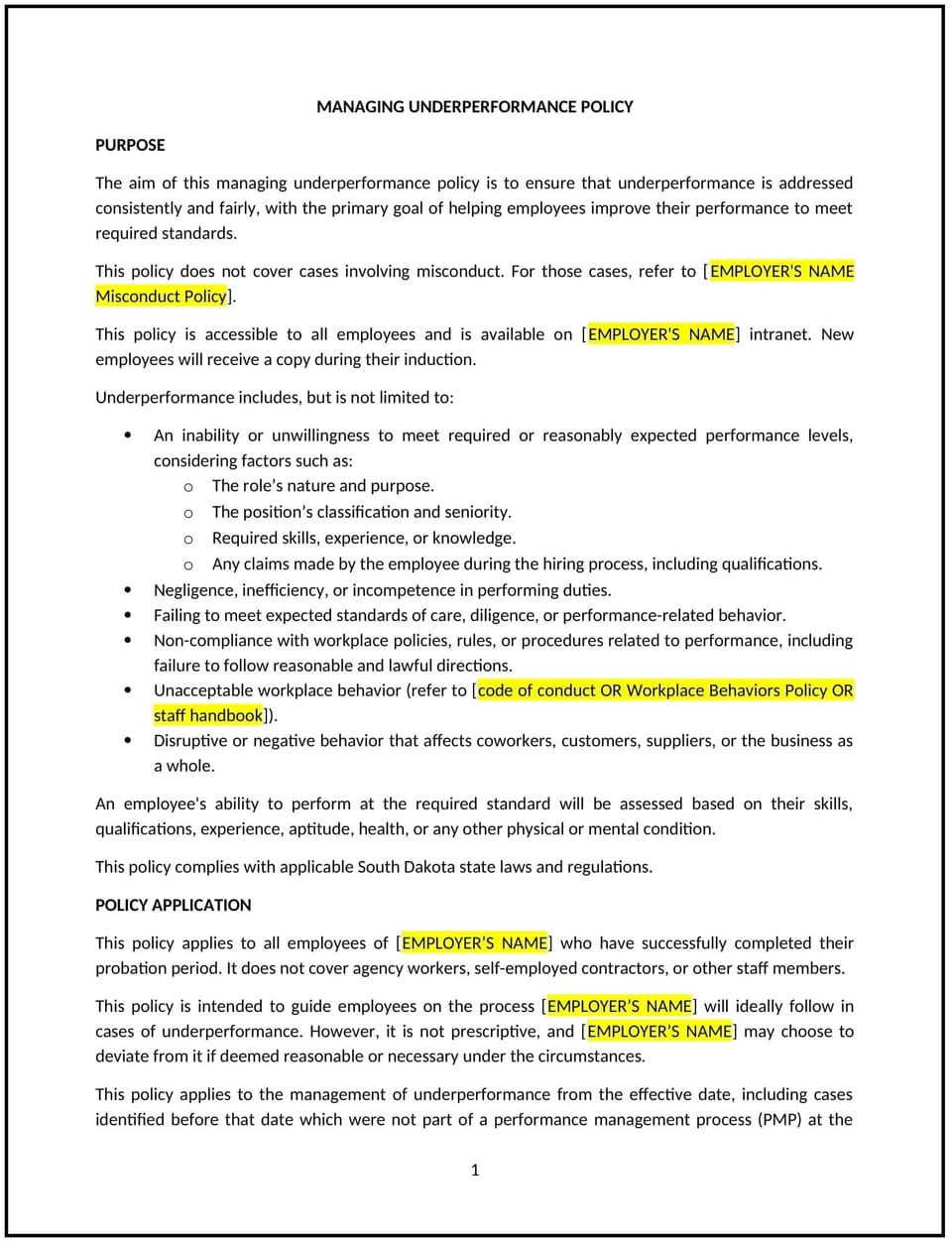Managing underperformance policy (South Dakota): Free template

Managing underperformance policy (South Dakota)
This managing underperformance policy is designed to help South Dakota businesses address employee performance issues effectively and fairly. It outlines procedures for identifying, addressing, and resolving underperformance in the workplace.
By adopting this policy, businesses can improve productivity, maintain a positive work environment, and align with general best practices for performance management.
How to use this managing underperformance policy (South Dakota)
- Define underperformance: Explain what constitutes underperformance, such as missed deadlines, poor quality work, or behavioral issues.
- Establish performance standards: Specify clear expectations for employee performance and behavior.
- Outline improvement plans: Provide steps for creating and implementing performance improvement plans (PIPs).
- Address communication: Specify how underperformance will be communicated to employees, including feedback and documentation.
- Train managers: Educate supervisors on handling underperformance fairly and constructively.
- Monitor progress: Regularly review employee performance to ensure improvement and compliance with the policy.
- Review and update: Assess the policy annually to ensure it aligns with evolving business needs and performance standards.
Benefits of using this managing underperformance policy (South Dakota)
This policy offers several advantages for South Dakota businesses:
- Improves productivity: Helps address performance issues promptly, ensuring teams remain effective and efficient.
- Maintains workplace culture: Demonstrates a commitment to fairness and accountability in performance management.
- Reduces turnover: Provides employees with opportunities to improve, fostering loyalty and retention.
- Builds trust: Shows employees that the business values their growth and development.
- Supports compliance: Aligns with best practices for performance management and employment laws.
Tips for using this managing underperformance policy (South Dakota)
- Communicate the policy: Share the policy with employees and include it in the employee handbook.
- Provide training: Educate managers on handling underperformance fairly and constructively.
- Monitor compliance: Regularly review performance management processes to ensure adherence to the policy.
- Address issues promptly: Take corrective action if underperformance is not addressed effectively.
- Update regularly: Assess the policy annually to ensure it aligns with evolving business needs and performance standards.
Q: How does this policy benefit businesses?
A: By addressing underperformance, businesses can improve productivity, maintain workplace culture, and reduce turnover.
Q: What is a performance improvement plan (PIP)?
A: A PIP is a structured plan to help employees improve their performance, including specific goals and timelines.
Q: Can employees dispute underperformance claims?
A: Yes, employees should have the opportunity to provide feedback or dispute claims during performance discussions.
Q: How should businesses handle repeated underperformance?
A: Businesses may consider further action, such as additional training, role adjustments, or termination, if underperformance persists.
Q: How often should businesses review this policy?
A: Businesses should review the policy annually or as needed to ensure it aligns with evolving performance standards.
This article contains general legal information and does not contain legal advice. Cobrief is not a law firm or a substitute for an attorney or law firm. The law is complex and changes often. For legal advice, please ask a lawyer.


